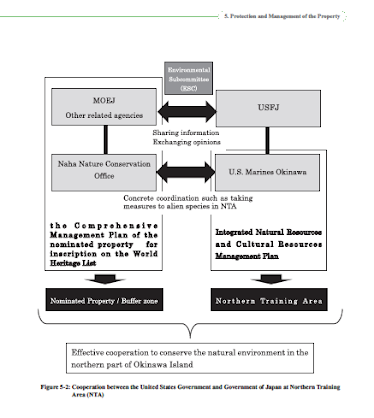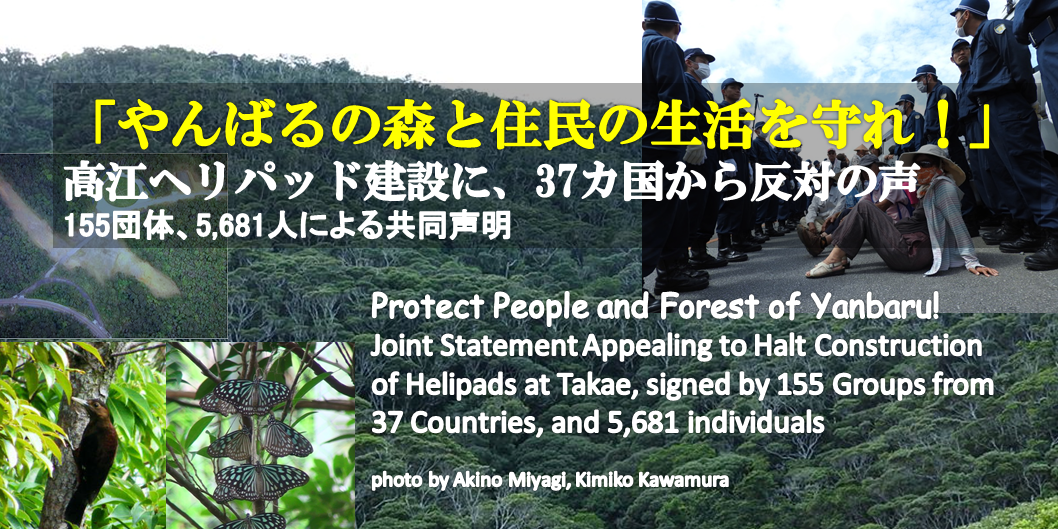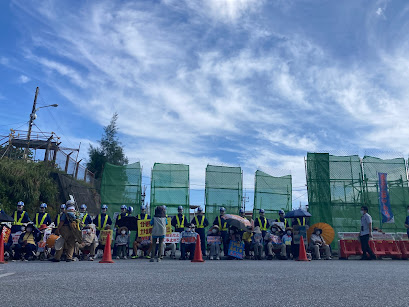OEJP's Take on the IUCN World Natural Heritage Recommendation/IUCN世界自然遺産勧告をどうみるか
(日本語版は下にあります)
On May 10, 2021, the Japanese Ministry of the Environment announced that the International Union for Conservation of Nature (IUCN) World Heritage (WH) Programme had just recommended that Amami-Oshima Island, Tokuno-Shima Island, the Northern Part of Okinawa Island, and Iriomote Island be inscribed as UNESCO World Natural Heritage sites at the 44th session of the UNESCO World Heritage Committee in July 2021.
IUCN is UNESCO's advisory body, and it is tasked with, among other things, evaluating and making recommendations regarding WH nominated sites.
 |
| Yambaru Forest Image Source: OEJP |
The Okinawa Environmental Justice Project (OEJP) has been engaging with the IUCN WH Programme, the Ministry of the Environment, the Okinawa Prefectural Government, and the U.S. Department of Defense in the nomination process over the last 5 years. OEJP has collaborated with local community members, experts, and NGOs in this endeavor. OEJP’s focus has been on the issues of the U.S. military's Northern Training Area (NTA) located adjacent to the nominated site, the Northern Part of Okinawa Island (locally referred to as the Yambaru forest, thus hereafter the Yambaru forest).
OEJP's Observation
As we had expected, the IUCN’s announcement has met with two contrasting reactions in Okinawa.
As we had expected, the IUCN’s announcement has met with two contrasting reactions in Okinawa.
One is of welcome and relief. This reaction was most apparent among the prefectural and municipal governments, and it was also shared by Okinawa’s general public.
The inscription of the Yambaru forest and Iriomote Island as World Natural Heritage sites has been a long-standing dream of the prefectural government and Kunigami Village, Higashi Village, and Ogimi Village, and Taketomi Town. And the Ministry of the Environment worked closely with these local governments. However, their first attempt was unsuccessful. In 2018, the IUCN recommended the ministry’s nomination be deterred, citing a range of issues, including the fragmentation of some of the nominated areas and the presence of the NTA in the Yambaru forest. The Ministry eventually withdrew its nomination.
Many believed thus that this second attempt was the last chance for these sites for world Heritage inscription. For the last three years, the Ministry and the local governments have worked hard to resolve the issues the IUCN WH Programme had pointed out in 2018, revising and resubmitting its application to the Programme in January 2019.
The other reaction is of apprehension, cynicism, or disappointment with the IUCN decision. The information provided by the Ministry of the Environment via the media to the public has no mention of whether or not the IUCN WH Programme addressed the issues of the NTA in its recommendation. Many have interpreted this as IUCN's failure to see the actual impacts of the NTA. Understandably, this reaction is most prevalent among those who have seen and experienced firsthand the problematic situations in and around the nominated site and the NTA.
Some areas of the former NTA land, now incorporated into the nominated area, are still littered with bullet shells, blanks, unexploded ordinance, and other discarded military materials. Some other areas have been contaminated with toxic chemicals. It is not clear how long clean-up and restoration will take. The loud noise from the U.S military's aircraft flying over the Yambaru forest has long affected the people's lives of the nearby communities and the animals inhabiting in and around the nominated area. In fact, after the Japanese government's submission of the application in February 2017, aircraft training and its noise have intensified.
 |
| Discarded blanks in Yambaru forest (photo taken during Fieldtrip organized by Akino Miyagi) Image Source: OEJP |
For those people, the IUCN decision is incomprehensible. It undermines the integrity of IUCN by rubber-stamping the controversial presence of a military training area next to a World Natural Heritage candidate site on a small island.
Okinawa Environmental Justice Project's Stance
The Okinawa Environmental Justice Project takes the following stance regarding the IUCN decision.
First, OEJP awaits the release of the IUCN WH Programme's formal evaluations of the nominated sites before making any appraisal of the IUCN decision. According to our communication with the IUCN WH Programme, the evaluations will be posted by June 4, 2021, on the following link.
http://whc.unesco.org/en/sessions/44COM/documents/
It is our understanding that the only entity in Japan that has access to the IUCN evaluations at this point is the Japanese government. And the only information available to the public is in the forms of press releases and related materials provided by the Ministry of the Environment.
In other words, the local governments, the media, the general public are reacting to the information provided in these materials, not to the IUCN formal evaluations. And, in the Ministry's press release materials, one sees little discussion on the NTA. But this does not mean the IUCN evaluations have dismissed the issues of the NTA.
OEJP is well aware that the Ministry has tendencies to downplay the issues of the NTA even when IUCN documents stated otherwise. Thus, OEJP awaits and encourages others to await the release of the IUCN formal evaluations. (OEJP plans to review and report how the IUCN WH Programme has addressed the issue of the NTA in its formal evaluations and recommendations)
Second, still, OEJP welcomes the IUCN decision. OEJP hopes that the UNESCO WH Committee will inscribe the Yambaru forest (Northern Part of Okinawa Island) as a WH site. OEJP acknowledges the Ministry's efforts to address the issues, including those of the NTA, the IUCN WH Programme had pointed out in its second attempt.
OEJP believes that the inscription of the Yambaru forest as a World Heritage site will give Okinawa more and better frameworks through which the issues of the NTA would be brought up and resolved.
If the Yambaru forest remains important only to Okinawa, not to the world, and if it remains a token "national park," our voice and action would make headlines in the local media only. But if it is inscribed as a World Heritage site, our voice and action can garner international attention and leverage. (We will write more on this after the Yambaru forest is inscribed as a WH site).
 |
| Protesters against construction of military landing zones in Yambaru forest (July 2017) Image Source: Ryukyu Shimpo |
Finally, OEJP believes that civil society needs to continue to play its critical roles in ensuring that the Northern Part of Okinawa Island is worthy of WH heritage status.
It is local community members, experts, NGOs that had tirelessly worked to direct the IUCN's attention to the issues of NTA in the nomination process when the Ministry of the Environment downplayed them and the Okinawa Prefectural and municipal governments went along with the Ministry. Consequently, in the second nomination document, the Ministry included information (albeit limited) on the NTA, a discussion on the collaboration between the Japanese and U.S. governments with the text of the "Document Concerning Cooperation with the United State Government in the Northern Training Area," a cooperation document of the U.S.-Japan Joint Committee.
The civil society raised its voice and took action because, learning from IUCN’s WH Programme and NGOs worldwide, we knew that the issues of the NTA needed to be addressed for the Yambaru forest to be considered for WH status. You don't need to hide the problems when you are determined to solve them. OEJP believes that, with the skills, knowledge, and determination, civil society members have a lot to contribute in ensuring the Yambaru forest is a great WH site.
 |
| Excerpt from the environment ministry's 2019 WH nomination document Image source: Ministry of the Environment |
For more information, see
Hideki Yoshikawa (2019) "Hesitant Heritage: U.S. Bases on Okinawa and Japan’s Flawed Bid for Yambaru Forest World Heritage Status." The Asia-Pacific Journal: Japan Focus.
日本語はここから
2021年5月10日、環境省は、IUCN (国渣自然保護連合)の世界遺産プログロムが、奄美大島、徳之島、沖縄本島北部、西表島を世界自然遺産として登録されるように勧告した、と発表した。登録の最終判断は7月に中国で行われる第44回ユネスコ世界遺産委員会で下される。
IUCNはユネスコの諮問機関であり、様々な役割を担っており、世界遺産(自然、複合)候補地を評価することもその役割である。
 |
| 世界遺産候推薦地 やんばるの森 Image Source: OEJP |
OEJPは、この5年間の登録申請過程において、他の環境団体や地域社会と協力しながら、IUCN世界遺産プロジェクト、環境省、沖縄県、米軍に働きかけてきた。特に候補地「沖縄本島北部」に隣接する米軍北部訓練場の問題を取り上げてきた。(推薦地の正式名称は「沖縄本島北部」であるが、沖縄ではその周辺も含めて「やんばるの森」として親しまれている。以下、候補地を「やんばるの森」としても記述。)
その立場から、今回のIUCNの登録勧告への県内の反応について、またOEJPとしての登録勧告へのスタンスを示していく。
沖縄における反応について
IUCNの登録勧告に対して、沖縄県内では対照的な二つの反応が起こっている。
まず一つは、歓迎、あるいは安堵という反応だ。これは県や関係自治体内で顕著であり、沖縄県民の多くも同様の反応を示している。
やんばるの森と西表島の世界自然遺産登録は、県、国頭村、東村、大宜味村、そして竹富町の長年の悲願である。県や自治体は環境省に協力し登録に向けての取り組みを行ってきた。しかし2017年の一回目の挑戦は成功しなかった。2018年5月に、IUCNは、飛び地や北部訓練場の問題を含む様々な問題を指摘し、「登録延期」(推薦書の作り直し)を勧告し、その後日本政府が推薦を取り下げた経緯がある。
多くの関係者は、今回の2度目挑戦が登録の最後のチャンスだと認識していたはずだ。そしてこの約3年の間、環境省と自治体はIUCNに指摘された問題点に対応し、推薦書を作り直し2019年2月に再提出し、登録に向けての努力を重ねてきた。
IUCNの登録勧告へのもう一つの反応は、懸念、皮肉、失望という言葉で表されるものだ。メディアを介して伝えられる環境省の情報では、IUCNが北部訓練場の問題を取り上げたのか分からず、IUCNは北部訓練場の問題から目を背けてしまったとの解釈が生まれている。北部訓練場やその周辺の実情を知る人々の中でこのような反応が顕著であることは当然だといえよう。
世界遺産候補地に組み込まれた北部訓練場跡地のなかでは、現在でも薬きょうや不発弾が次々と確認されており、化学物質による土壌汚染の場所も確認されている。それらの除去や環境の回復にどれくらい時間がかかるのかも分からない。やんばるの森の上空で訓練する米軍機の爆音は、地域で暮らす人々はもちろん、候補地やその周りの生物に影響を与えている。実際、環境省が2017年に最初に推薦書を提出して以来、米軍機による訓練や騒音は増加している。
 |
| 世界遺産候補地で見つかり続ける空砲や薬きょう (宮城秋乃さんとのフィールドワークから) Image Source: OEJP |
この状況を踏まえれば、IUCNの登録勧告は理解し難いものだとえいよう。世界遺産候補地のすぐ隣に軍事基地が存在する状況を問題なしとする判断は、IUCN自体のインテグリティ(科学性に基づく原則と価値観、国際機関としての責任や権威)を形がい化するものだと批判がでるのも仕方がない。
IUCNの登録勧告に対するOEJPのスタンス
OEJPは今回のIUCNの登録勧告に対して以下のスタンスをとる。
まず1点目として、OEJPは、IUCNの登録勧告についての判断は、IUCN世界遺産プログラムの公式評価が公開されるのを待つべきである、と考える。環境省の発表後、OEJPはIUCN世界遺産プログラムに直接確認したが、公式評価はまだ一般には公開されておらず、6月4日までに以下のユネスコ世界遺産センターのリンクで公開されるということであった。
http://whc.unesco.org/en/sessions/44COM/documents/
OEJPは、現時点でIUCNの公式評価にアクセスできるのは政府だけだと理解している。つまり、IUCNの公式評価についての情報は環境省によるプレスリリースや関連文書を通しての情報のみである。
言い換えれば、現在県や自治体、メディア、人々の反応は、IUCNの正式評価にではなく、環境省が提供する情報への反応である。そして環境省のプレスリリースや関連文書では、北部訓練場への言及はほとんどない。しかしそれをもって、IUCNの正式評価書においても北部訓練場の問題が扱われていない、とは必ずしもいえない。
OEJPはこれまでの経験から、IUCNの文書で北部訓練場の問題が取り上げられている際も、環境省は(特に国内一般向けの情報においては)、北部訓練場の問題については大きく取り上げない傾向があることを認識している。それゆえ、OEJPはIUCNの公式評価の公表を待つべきだと考えている。(IUCNの公式評価の公開後、OEJPは公式評価のなかで北部訓練場の問題がどのように扱われているかを検証し、報告する)
2点目として、OEJPは、IUCNの登録勧告を歓迎し、またユネスコ世界遺産委員会がヤンバルの森を世界遺産に登録することを希望する、という立場である。IUCNが登録勧告を出すに至ったという意味で、登録再挑戦に向けた環境省の努力、特に北部訓練場の問題についての対応の努力も認めたい。
OEJPは、やんばるの森(沖縄本島北部)が世界遺産に登録されることにより、より多くのそしてより効果な枠組みによって、北部訓練場の問題を提起し、解決に向けて取り組めると考えている。(この点については登録後に!)
 |
| Image Source: Friends of Earth Japan |
やんばるの森が、沖縄にとってのみ重要で、また形だけの「国立公園」のままならば、私たちの声や行動を取り上げてくれるのは沖縄のメディアだけとなるだろう。しかし、世界遺産となれば、私たちの声や行動は、国際社会の関心や力を引きつけることもできるはずだ。
最後に、OEJPは、やんばるの森を真の世界遺産にしていくために、市民社会が今後もその重要な役割を果たし続けていくことが必要だ、と考えている。
遺産登録の取り組みにおいて、環境省が北部訓練場の問題を矮小化し、沖縄県や自治体が環境省に同調するなか、北部訓練場の問題についてIUCNに直接訴え理解を促してきたのは、地域住民であり、地域で活動する専門家であり、そしてNGOsである。その結果として、環境省の2019年の申請書において、北部訓練場の問題や米軍との取り決めが明記されたのである。
市民社会がIUCNに直接訴えたてきたのは、やんばるの森が世界遺産に登録されるには北部訓練場の問題は避けてはいけない問題だと認識していたからだ。その認識は、市民社会がIUCN世界遺産プログラムや世界のNGOから学んできたものだ。OEJPは、市民社会がそのスキルと知見と決意をもって、やんばるの森を真の世界遺産にするために今後も大きく貢献できると考えている。
以上
北部訓練場の問題とやんばるの森の世界遺産登録も経緯については以下の論文でも読めます。
Hideki Yoshikawa (2019) "Hesitant Heritage: U.S. Bases on Okinawa and Japan’s Flawed Bid for Yambaru Forest World Heritage Status." The Asia-Pacific Journal: Japan Focus.



